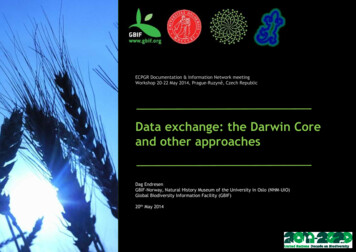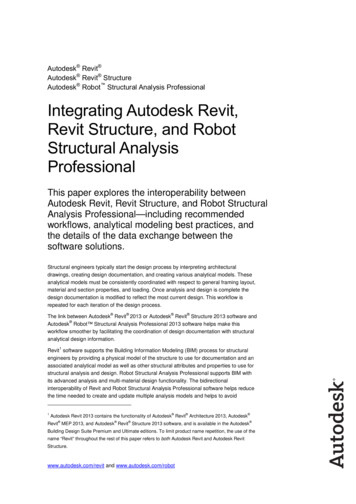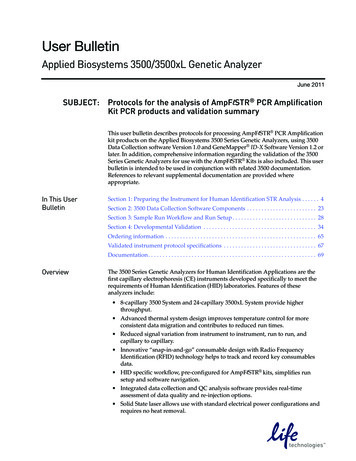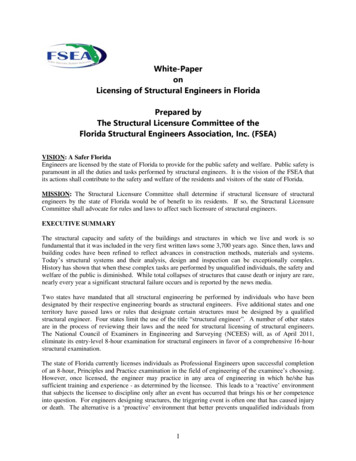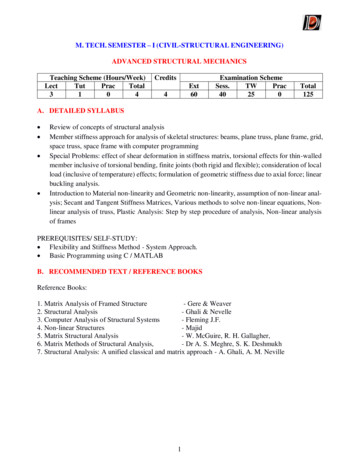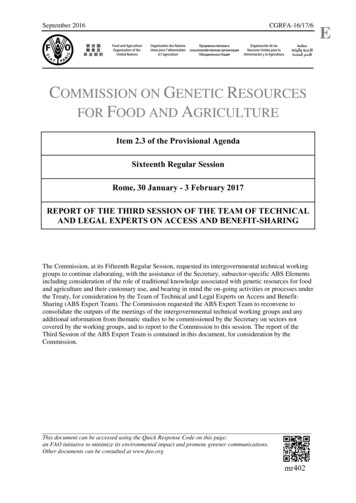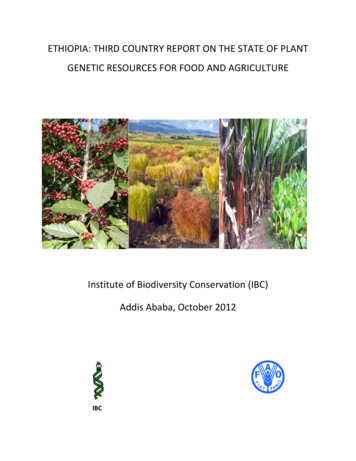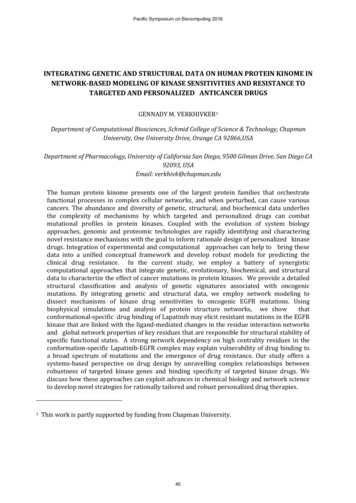
Transcription
Pacific Symposium on Biocomputing 2016INTEGRATING GENETIC AND STRUCTURAL DATA ON HUMAN PROTEIN KINOME INNETWORK-BASED MODELING OF KINASE SENSITIVITIES AND RESISTANCE TOTARGETED AND PERSONALIZED ANTICANCER DRUGSGENNADY M. VERKHIVKER †Department of Computational Biosciences, Schmid College of Science & Technology, ChapmanUniversity, One University Drive, Orange CA 92866,USADepartment of Pharmacology, University of California San Diego, 9500 Gilman Drive, San Diego CA92093, USAEmail: verkhivk@chapman.eduThe human protein kinome presents one of the largest protein families that orchestratefunctional processes in complex cellular networks, and when perturbed, can cause variouscancers. The abundance and diversity of genetic, structural, and biochemical data underliesthe complexity of mechanisms by which targeted and personalized drugs can combatmutational profiles in protein kinases. Coupled with the evolution of system biologyapproaches, genomic and proteomic technologies are rapidly identifying and characteringnovel resistance mechanisms with the goal to inform rationale design of personalized kinasedrugs. Integration of experimental and computational approaches can help to bring thesedata into a unified conceptual framework and develop robust models for predicting theclinical drug resistance. In the current study, we employ a battery of synergisticcomputational approaches that integrate genetic, evolutionary, biochemical, and structuraldata to characterize the effect of cancer mutations in protein kinases. We provide a detailedstructural classification and analysis of genetic signatures associated with oncogenicmutations. By integrating genetic and structural data, we employ network modeling todissect mechanisms of kinase drug sensitivities to oncogenic EGFR mutations. Usingbiophysical simulations and analysis of protein structure networks, we showthatconformational-specific drug binding of Lapatinib may elicit resistant mutations in the EGFRkinase that are linked with the ligand-mediated changes in the residue interaction networksand global network properties of key residues that are responsible for structural stability ofspecific functional states. A strong network dependency on high centrality residues in theconformation-specific Lapatinib-EGFR complex may explain vulnerability of drug binding toa broad spectrum of mutations and the emergence of drug resistance. Our study offers asystems-based perspective on drug design by unravelling complex relationships betweenrobustness of targeted kinase genes and binding specificity of targeted kinase drugs. Wediscuss how these approaches can exploit advances in chemical biology and network scienceto develop novel strategies for rationally tailored and robust personalized drug therapies.†This work is partly supported by funding from Chapman University.45
Pacific Symposium on Biocomputing 20161. BackgroundThe era of significant scientific breakthroughs and technological advancements in geneticsand biology has brought to clinical settings personalized health care that has the capacity todetect the onset of disease at its earliest stages and preempt the progression of disease. Thecomprehensive cancer genome characterization efforts have refined our understanding ofspecified genes responsible for development and progression of tumors1. Severalmalignancies are associated with the mutation or increased expression of protein kinases,including lung, breast, stomach, colorectal, head and neck, and pancreatic carcinomas andglioblastoma2. Tumor sequencing efforts have identified a rich source of naturally occurringmutations with many being simple single nucleotide polymorphisms (SNPs) in proteinkinases. A subset of these SNPs occurs in the coding regions (cSNPs) of kinases and result ina change in the encoded amino acid sequence (nonsynonymous coding SNP; nscSNPs).Genome studies have revealed the importance of “driver” somatic alterations that activatecrucial oncoproteins such as EGFR, BCR-ABL, and other kinase genes. Mutations in theseprotein kinases are often implicated in many cancers and exemplify the phenomenon of‘oncogene addiction,’ according to which the effects of driver genomic alterations arepivotal for tumor proliferation and have a selective advantage for the formation of thetumor during somatic cell replication3.Oncogene dependencies induced by geneticalterations in BCR-ABL, KIT, EGFR and other kinase genes are well known and have provideddecisive clinical proof of principle for the genomics-informed drug discovery of kinasedrugs4. Although tumor dependencies driven by dominant oncogenes could respond totargeted therapies, clinical responses to single agents are often followed by thedevelopment of drug resistance. The tumor dependency concept is especially relevant tounderstand mechanisms of acquired resistance, where resistant mutations, seeminglydeveloped due to drug treatment, may instead represent evolutionary selection of cellsubpopulations which harbor preexistent somatic mutant variants which confers a primaryresistance to these cells and provides them with a selective advantage. The spectrum of lungcancer EGFR mutations can induce oncogenic transformation by leading to constitutivekinase activity of EGFR and confer markedly different sensitivity to EGFR inhibitors5. Themost common reported mutations are the deletion of five exon-19 residues and the exon-21substitution L858R in the catalytic domain of EGFR6. Together, these mutations correspondto more than 90% of the activating EGFR mutations observed in non-small-cell lung cancer(NSCLC). While T790M has only a modest effect on EGFR function, a tandem of T790M andL858R mutations can result in a dramatic enhancement of EGFR activity. More than 200activating and drug resistance EGFR mutations with different clinical responses to tyrosinekinase inhibitors have been reported7 and molecular mechanisms of mutation-inducedkinase activation have been extensively discussed8.Gefitinib and Erlotinib are orally effective protein-kinase targeted inhibitors that areused in the treatment of ERBB1/EGFR-mutant lung cancer. Afatinib is another EGFR-46
Pacific Symposium on Biocomputing 2016targeted kinase drug approved by the FDA for the first-line treatment of patients withmetastatic NSCLC whose tumors have EGFR exon 19 deletions or exon 21 (L858R)substitutions. Lapatinib, a small molecule tyrosine kinase inhibitor of both EGFR andHER2/ErbB2 is now also approved for advanced HER2-amplified breast cancer9. Structuraland biochemical studies have characterized the inhibition of intrinsic catalytic activity ofEGFR and HER2/Erbb2 variants by Lapatinib using a diverse array of enzymatic and cellbased assays10,11. Cell-based EGFR resistance mutation screens have demonstrated thatLapatinib produced the broadest mutation spectra of any of the EGFR-targeted drugs testedin in vitro system, with a number of Lapatinib-specific resistant mutations clustered aroundthe selectivity pocket and the EGFR-A-loop12. The association between EGFR mutations anddifferential drug sensitivity suggested that genetic EGFR alterations and correspondingchanges in structural and interaction profiles of the EGFR kinase domain render tumorssensitive to selective inhibitors.Oncogenic kinases can adopt different mechanisms toalleviate negative regulatory processes associated with their intrinsic conformationalinstability. One of them is the recruitment of unstable kinase forms to the Hsp90 system thatprotects abnormally activated kinases in cancer cells13. HSP90 stabilizes viral kinases andvarious mutated oncogenes, including oncogenic EGFR mutants that are dependent on thechaperoning function through direct interactions to maintain their stability14. HSP90inhibition reduces mutant EGFR levels and activity, suggesting a viable EGFR inhibitionstrategy. Crystallographic studies15 have supported this mechanism by showing that thecatalytic domains of the EGFR-L858R and EGFR-L858R/T790M oncogenic mutants canadopt flexible inactive conformations that may facilitate conformational release from theautoinhibitory state. This may be exploited by the Hsp90 chaperone to bind the unstablemutant conformations and promote an accumulation of a constitutively active form.According to the newly emerging paradigm, kinase inhibitors may exert their primary effectby “arresting” the kinase domain in the specific inactive form, thereby depriving the Hsp90system from access to unstable conformational states and preventing uncontrollableaccumulation of the active form16.The abundance and diversity of genetic, structural, and biochemical data underlies thecomplexity of mechanisms by which targeted and personalized kinase agents can combatmutational profiles in EGFR kinase. We employ a battery of synergistic computationalapproaches that integrate genetic, biochemical, and structural data to characterize theeffect of cancer mutations in protein kinases. We show that binding specificity and drugresistance of EGFR drugs may be linked with the global network properties of key residuesthat are responsible for structural stability of specific targeted conformations. The results ofthis study offer a network-based perspective on drug design of targeted and personalizedkinase drugs, showing how the efficiency and robustness of the interaction networks may beassociated with kinase binding preferences and emergence of resistant mutations.47
Pacific Symposium on Biocomputing 20162. Methods2.1. Data miningProtein kinase sequences were obtained from Kinbase (http://kinase.com/kinbase/).Common SNPs were retrieved from PupaSNP and dbSNP using the Ensembl data mining tool,Biomart (http://www.ensembl.org/Homo sapiens/martview). The disease causing SNPswere retrieved from OMIM, KinMutBase, and HGMD databases. We used all kinase geneentries referenced in NCBI and SwissProt database, and 7955 unique SNP entriescorresponding to these kinase genes as they are referenced in NCBI. These unique SNPentries include 3722 synonymous, 3985 missense, 75 nonsense and 173 frameshiftmutations. We have also gathered 780 OMIM variant entries from NCBI and 3542 SwissProtvariant entries. Cancer mutations were retrieved from OMIM and COSMIC databases.Motif-based alignments of kinase sequences to the catalytic core were first generated byimplementation of the Gibbs motif sampling method. This method identifies characteristicmotifs for each individual subdomain of the kinase catalytic core, which are then used togenerate high-confidence motif-based Markov chain Monte Carlo multiple alignments basedon these motifs17. The nsSNPs were then mapped to the kinase catalytic domain inaccordance with this alignment. Cancer driver predictions were performed by using theSVM approach as described in the earlier work18.2.2. Somatic mutation distributions and driver mutation hotspots in protein kinomeFunctionally important subdomains of the kinase catalytic core were examined to determinethe distribution of nsSNPs and identify structurally conserved hotspots of functionallyimportant mutations. The number of SNPs in each of the subdomains was calculated fromthe structure-informed multiple sequence alignment. The expected probability E(p) of a SNPoccurring in a kinase subdomain region was calculated separately for each SNP type. In brief,the average length of each region was calculated as the weighted average of the regionlength in each kinase considered, where weights correspond to the total number of SNPsoccurring within each kinase. The probability of a SNP occurring within a particular regionpurely by chance was computed as its weighted average length over the sum of everyregion's weighted average length. The probability (p-value) of the observed total number(x) of SNPs occurring within each region, where n is the total number of SNPs considered,was calculated using the general binomial distribution. The average length of each subdomain was calculated as the weighted average of the region length in each kinaseconsidered, where weights correspond to the total number of SNPs occurring within eachkinase. The probability of a SNP occurring within a particular region purely by chance wascomputed as its weighted average length divided by the sum of every region’s weightedaverage length. The probability (p-value) of the observed total number of SNPs occurringwithin each region was then calculated using the general binomial distribution. Cancer48
Pacific Symposium on Biocomputing 2016mutant predictions and analysis were performed as described in previous studies21. Asupport vector machine (SVM) was trained upon common SNPs (presumed neutral) andcongenital disease causing SNPs characterized by a variety of sequence, structural, andphylogenetic parameters. The threshold taken for calling a SNP a driver is 0.49 for catalyticdomain mutations, and 0.53 for all other mutations.2.3. Network modeling of residue interaction networks in protein kinasesMolecular dynamics (MD) simulations were carried out using NAMD 2.6 with theCHARMM27 force field19. The binding free energies and computational alanine scanning ofkinase-drug complexes were doneusing MM-GBSA approach20.A graph-basedrepresentation of proteins was used in the protein structure network analysis, whereresidues were considered as nodes and edges correspond to the nonbonding residue-residueinteractions. The pair of residues with the interaction strength I ij greater than a userdefined cut-off I min are connected by edges and produce a protein structure network graphfor a given interaction strength I min . The strength of interaction between two amino acidside chains is I ijnij( Ni N j ) 100 (1)where nij is number of distinct atom pairs between the side chains of amino acid residues iand j that lie within a distance of 4.5 Å. N i and N j are the normalization factors forresidues i and j respectively21. We considered any pair of residues to be connected if I minwas greater than 3.0%. A weighted network representation of the protein structure isadopted thatincludes non-covalent connectivity of side chains and residue crosscorrelation fluctuation matrix22. In this model, the weight wij of an edge between nodes iand j is measured as wij log( Cij ) where Cij is the element of the covariance matrixmeasuring the cross-correlation residue fluctuations obtained from MD simulations. Theshortest paths between two residues are determined using the Floyd–Warshall algorithm.We computed the residue-based betweenness which is defined as the sum of the fraction ofshortest paths between all pairs of residues that pass through residue i :Ng jk (i )j kg jkCb (ni ) (2)where g jk denotes the number of shortest geodesics paths connecting j and k , and g jk (i ) isthe number of shortest paths between residues j and k passing through the node ni .49
Pacific Symposium on Biocomputing 20163. Results3.1. Structural and functional signatures of cancer mutations in protein kinasesGenetic variations in protein kinase genes are widely spread across both phylogenetic andstructural space, and only a subset of all SNPs could be directly mapped to the kinasecatalytic domain (Figure 1A). We constructed the distribution of various SNPs categoriesthat could be mapped onto the 12 functional subdomains (SDs) of the kinase catalytic core(Figure 1B). Structural mapping of sSNPs resulted in a uniform coverage of kinasesubdomains, showing only a weak preference towards SD II which has no obviousfunctional role in kinase regulation. The distribution of nsSNPs pointed to the preferentialbias towards specific functional regions. Functionally important P-loop (SD I), hinge region(SD V), catalytic loop (SD VIB), and A-loop (SD VII) along with the P 1 loop region (SD VIII)are more densely populated The catalytic domain of protein kinases harbors a large numberof SNPs falling into three major categories: common and neutral SNPs; inherited diseasecausing germline SNPs; and cancer causing SNPs. By compiling and mapping a total of 355common SNPs, 428 inherited disease causing SNPs, and 541 cancer associated SNPs wefound a statistically significant enrichment of different categories of SNPs in specific lregions of the catalytic domain (Figure 1C). Common nsSNPs are randomly distributedwithin the catalytic core, only sparsely populating functional segments of the catalytic core,such as the catalytic or A-loops, whereas these nsSNPs more densely occupy evolutionaryunconserved regions of the C-terminal tail. The disease-causing nsSNPs primarily mappedto the regions involved in regulation and substrate binding, such as the APE-loop and theP 1 region, as well as the catalytic loop (Figure 1C). Cancer-associated nsSNPs tend to targetregions directly involved in the catalytic activity that are mainly localized in the P-loop, Aloop and catalytic loop. The distribution of kinase nsSNPs across functional kinasesubdomains suggested that the kinase regions that are enriched in different types of SNPsare markedly different and have only a minimal overlap. The distribution revealed apreference for cancer-causing nsSNPs to populate primarily the A-loop (SDVII) and the Ploop (SD I). The functionally important for substrate and protein binding P 1 loop areenriched largely in disease-associated mutations, but not cancer-causing mutations. Theseresults indicated that disease-associated mutations could primarily affect the kinaseregions involved in functional regulation, allosteric interactions and substrate binding23.Kinome-wide analysis of sequence and structure-based signatures of cancer mutationsrevealed that a significant number of cancer mutations could fall at structurally equivalentpositions within the catalytic core. These structurally conserved mutations tend to clusterinto specific mutational hotspots which may be shared by multiple kinase genes. Weclassified cancer mutation hotspots which had been identified as a frequent target oftumorigenic activating mutations. Cancer mutation hotspots in protein kinases are largelylocalized within the P-loop, hinge region, and A-loop (Figure 1).50
Pacific Symposium on Biocomputing 2016Figure 1. The distribution of nsSNPs in the catalytic core (A,C). The catalytic domain was subdividedinto 12 subdomains (B) with some subdomains corresponding to functional regions : SD I (P-loop);SDIII(αC-helix); SDV (hinge region); SDVIB (catalytic loop); SDVII (A-loop) ; SDVIII (P l loop).(B)Structural mapping is shown for common nsSNPs , disease-causing nsSNPs , and cancer-causingnsSNPs. (D) Structural localization of driver mutations is mapped onto the crystal structure of theactive EGFR (pdb entry 2J6M). Structural annotation of cancer driver mutations is arrangedaccording to their oncogenic potential. The higher the oncogenic potential of the cancer drive, thelarger the ball denoting structural position of the respective mutation.3.2 Structural bioinformatics analysis of oncogenic kinase mutants: distinct structuralsignatures of Hsp90-dependent kinase clients are associated with oncogenic potentialOncogenic kinase mutants may rely on the Hsp90 dependence for the maintenance ofstability and accumulation of the constitutively active form. In particular, Hsp90 function isessential to maintain high-level expression of mutant EGFR in lung cancer cells14. Weperformed kinome-wide structural bioinformatics analysis of chaperone-regulated kinases(Figure 2). The proteomics-based client annotation (Figure 2A) was compared againststructure-based mapping of the Hsp90-Cdc37 kinase clients (Figure 2b). Structural couplingof the catalytic DFG motif and the regulatory αC-helix is recognized as central in controllingkinase activity and dynamic equilibrium between the inactive (DFG-out/αC-helix-in), theCdk/Src-like inactive (DFG-in/αC-helix-out) and the active kinase forms (DFG-in/αC-helixin). Although many of the Hsp90 kinase clients can occupy evolutionary different branches51
Pacific Symposium on Biocomputing 2016of the human kinome, we found they share a common Cdk/Src- type structural arrangementof their inactive functional states. The Cdk/Src-like inactive structures shared by the Hsp90kinase clients are unified by a common structural determinant whereby the regulatory αChelix is moved to a αC-out conformation and forms autoinhibitory clamp with the A-loop,thus preventing the formation of the catalytically competent active kinase.Figure 2. The distribution of the Hsp90-dependent protein kinase clients in the human kinome. (A)Kinome mapping of Hsp90-Cdc37 clients discovered in proteomic-based studies16 is depicted. Thekinases that are found to be downregulated by Hsp90 inhibition in the experimental profiling areshown in yellow (confirmed kinase clients) and red (novel kinase clients from proteomics studies16).(B) Structure-based mapping of the Hsp90-Cdc37 kinase clients. The Cdk/Src kinase clients aremarked in blue filled spheres. A high density of the Cdk/Src clients in the TK, TKL, STE, CAMK, andCMGC groups of the human kinome tree is highlighted by blue circles. The second category of kinaseclients is characterized by active structures stabilized through allosteric interactions (green spheres).According to our analysis, oncogenic kinase mutations in the conserved hotspots (Aloop), may perturb the constraints keeping the αC-helix-out in the rigid inactive position,and allow the A-loop to assume an extended active conformation (A-loop open) that is seenin the as crystal structures of the EGFR-L858R and EGFR-L858R/T790M mutants15. TheseCdk/Src-like active conformations that can be adopted by oncogenic mutants are far moreflexible and unstable. As a result, they may be sequestered by the Hsp90 to promoteuncontrollable transformation and accumulation of the constitutatively active state forkinase cancer mutants.52
Pacific Symposium on Biocomputing 20163.3 Integrating genetic and structural data on oncogenic EGFR mutations: modeling ofthermodynamic and networking signatures of targeted drug bindingBy using MD simulations and MM-GBSA binding free energy simulations, we evaluated thethermodynamic effect of oncogenic EGFR mutations on different conformational states ofEGFR (Figure 3A). Our results showed that oncogenic mutations L747P, L747S, L858R andL861Q can destabilize the rigid autoinhibitorystructure that is thermodynamically24favorable in the wild-type EGFR . Strikingly, oncogenic mutations L747P/S, L858R andL861Q seemed to favor a highly flexible Cdk/Src –active conformation and marginallydestabilize the active conformation. As a result, EGFR mutations with a high oncogenicpotential may destabilize the dormant autoinhibitory structure. These mutations may inducefast equilibrium between flexible Cdk/Src-like active conformation and active structure thatcould lead to uncontrollable activity, which is a “deadly” signature of cancer mutations. Themajor Lapatinib-resistant mutations with the high oncogenic potential occurred in theresidues that do not directly contact ligand. L747 is located at a loop adjacent to αC-helix;V765 and V769 are at or near the C-terminal portion of αC-helix, and T790is at thegatekeeper position in the ATP binding site. Of the remainder, N857 is located in helix D,T854 forms the base of the ATP binding site, L858 and H870 are in the A-loop (Figure 3). Todetermine the thermodynamic contribution of the EGFR residues to Lapatinib binding andidentify energetic hot spots susceptible to mutations, we performed free energy simulationsand computational alanine scanning (Figure 3B). First, we found that only some Lapatinibinteracting residues corresponded to cancer mutation hotspots, suggesting that escapingbinding interactions with the drug via mutations may not be a primary mechanism thatdrives emergence of Lapatinib-resistant mutations. The energetic hot spots of Lapatinibbinding that corresponded to cancer mutation drug-resistant EGFR sites included L718,L777, L788, T790 (gate-keeper), and T854 residues. However, the EGFR mutations of highoncogenic potential that can render differential sensitivity to Lapatinib such as L747, L858,and L861 make fairly moderate contributions to binding energetics that could not explainhigh resistance. These results suggested that the mechanism of Lapatinib-induced somaticmutations may rather be associated with the intrinsic stability of the Cdk/Src inactive EGFRstructure that binds Lapatinib10-12. Several hypotheses have suggested that the mechanismof Lapatinib-induced somatic mutations is linked with a conformation-specific mode ofLapatinib binding to an inactive EGFR structure11,12 as drug resistant cancer mutations maystabilize the constitutively active EGFR form and thus interfere with the drug binding. Totest this mechanism, we evaluated organization of the residue interaction networks andstructural stability of EGFR states. The stability of the inactive EGFR conformation targetedby Lapatinib is mediated by interaction networks formed by high centrality residues F723(P-loop), αC-helix (V765, M766, and V769), the αC-β4-loop (L774), the HRD motif (H835,D837), DFG motif (D855, F856) and L858 (A-loop) (Figure 3C, Table 1). The central result ofthe network analysis showed that although some somatic mutations may emerge in residues53
Pacific Symposium on Biocomputing 2016with medium centrality, Lapatinib-resistant cancer mutations can be developed in highcentrality sites that determine interaction network of the specific EGFR form (Table 1). Dueto their central position in the structural network, mutations of V765 and V769 (αC-helix)and L858 (A-loop) can severely compromise the integrity of the interaction network byweakening or dissolving the central autoinhibitory lock between the P-loop/A-loopinteractions holding the αC-helix in the inactive position. Targeted mutations of these highcentrality sites could disrupt allosteric coupling between functional regions, leading to theweakening and fragmentation of the residue interaction network. A strong networkdependency on high centrality residues may explain a broad spectrum of Lapatinib-resistantmutations that are located away from the inhibitor, near the αC-helix and in the A-loop.Hence, residue centrality may be used as a metric for assessing severity of drug resistancemutations and differentiating between highly resistant and moderately resistant positions.Figure 3. Structure-based network modeling of EGFR cancer mutations and drug binding. (A) Freeenergy changes caused by oncogenic mutations in different conformational states of EGFR. (B)Computational alanine scanning of binding site residues in the Lapatinib-EGFR complex (pdb id1XKK). (C) The residue centrality profile of Lapatinib-EGFR complex (in blue). EGFR mutations areshown in green diamonds and Lapatinib-resistant oncogenic mutations are shown in red diamonds.(D) Structural mapping of EGFR cancer mutations (blue spheres) on the crystal structure ofLapatinib-EGFR complex (green ribbons). Mapping of Lapatinib-resistant mutations (indicated byarrows) on the crystal structure of Lapatinib-EGFR complex colored according to structural stability.54
Pacific Symposium on Biocomputing 2016Table 1: Structure-based network analysis of the EGFR kinase domain and Lapatinib-EGFR complex.Structural region and network centrality of functional EGFR residues targeted by cancer mutationsand drug resistant mutations are reported.Residue Residue# 75F/R/YArg7760.09576 ALeu8580.10864 L858R/Q/K/V/MLys8600.05991K860T/E/ILeu8610.07540 xon 18β1 strandExon 19Gly-rich P-loopExon 19β3-αC loopExon 20αC-helixExon 20αC-helixExon 20αC-β4 loopExon 20αC-β4 loopExon 20αC-β4 loopExon 20αC-β4 loop(R-spine)Exon 20β4 strandExon 20β5 strandβ5 strandExon 20Exon 20αD-αE loopExon 20αE-helixβ7strand (C-spine)Exon 21Exon 21β7strandβ7strandExon 21Exon 21Short helix/A-loopExon21Short helix/A-loopExon 21Short helix/A-loopExon 21A-loopExon 22A-loopExon 23αI-helixOur study suggests that binding of selective and personalized kinase agents can be linkedwith the robustness of the residue networks in kinase structures. We have found thatselective EGFR inhibitors with preferential binding to specific inactive conformations, suchas Lapatinib, could be vulnerable to a broad spectrum of resistant mutations pointing to a“dark side” of targeted agents that reflects the inherent conflict between the efficiency androbustness of kinase drugs. The association of network properties with kinase regulationand drug binding suggests that residue interaction networks may be reorganized andspecifically tailored through therapeutic agents targeting high centrality residue nodes.Integration of genetic, biochemical and structural data in the unified framework of proteinstructure networks and systems biology may help to understand and rationally exploit thecomplex relationships between robustness of targeted genes and binding specificity ofpersonalized drugs.55
Pacific Symposium on Biocomputing 2016References1.E.D. Pleasance, R.K. Cheetham, P.J. Stephens, D.J. McBride et al., Nature 463, 191 (2010).3.I.B. Weinstein IB. Science 297, 63 (2002).2.4.5.6.7.8.9.Z.Kan, B.S. Jaiswal, J. Stinson, V. Janakiraman V et al., Nature 466, 869 (2010).W. Pao, V.A. Miller, K.A . Politi, G.J. Riely et al., PLoS Med. 2, 12 (2005).H. Shigematsu, T. Takahashi, M. Nomura, K. Majmudar et al., Cancer Res. 65, 1642 (2005).C.H. Yun, K.E. Mengwasser, A.V. Toms AV, M.S. Woo, et al., Proc. Natl. Acad. Sci. U.S.A. 105, 2070(2008).E. Massarelli, F.M. Johnson, H.S. Erickson, Wistuba II, and V. Papadimitrakopo
INTEGRATING GENETIC AND STRUCTURAL DATA ON HUMAN PROTEIN KINOME IN . University of California San Diego, 9500 Gilman Drive, San Diego CA 92093, USA Email: verkhivk@chapman.edu . The human protein kinome presents one of the largest protein families that orchestrate . domain was calculated as the weighted average of the region length in each .

